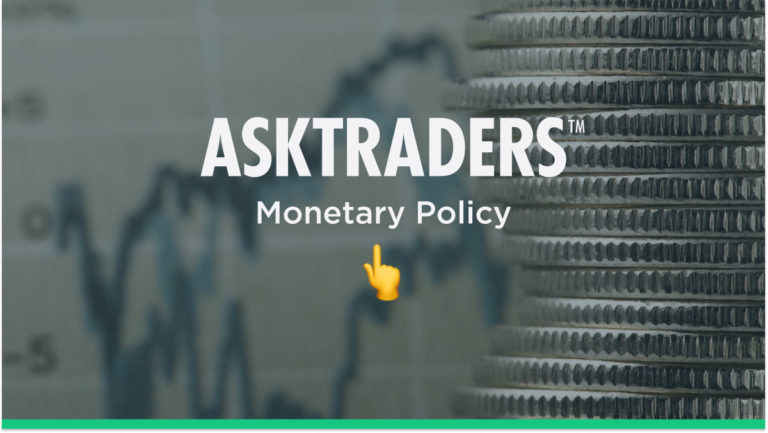
These can include economic data such as inflation, central bank activity, and geopolitical factors, such as elections, military conflicts, natural disasters, and trade wars. We can also count investor and trader sentiment. In this post, we are going to focus on central bank activity, and in particular monetary policy. We will present a beginner-to-intermediate guide to all things monetary policy and how it impacts different financial markets and asset classes.
- What Is Monetary Policy?
- What Are The Types Of Monetary Policy? Contractionary and Expansionary
- What Are The Instruments Of Monetary Policy?
- How Does Monetary Policy Impact Different Asset Classes?
What Is Monetary Policy?
Monetary policy is the process by which a central bank or other monetary authority manages the money supply in an economy. The financial authority usually has certain objectives it will establish. These include maintaining price stability, supporting the government's fiscal policies, maintaining a low interest rate, reducing unemployment or boosting economic growth.
Some of these goals go hand in hand and some are harder to quantify. So to make this easier, the central bank often sets an inflation target. The Bank of England sets its at 2%. This sets the central bank a clear target that will help achieve its goals along with allowing economic agents to be able to plan for the future more easily.
In order to achieve these objectives, the monetary authority uses a variety of tools, such as open market operations, reserve requirements, and interest rates. Monetary policy can be expansionary or contractionary, depending on whether the goal is to increase or decrease the money supply. It is often used in conjunction with fiscal policy, which is the use of government spending and taxation to achieve economic goals.
What Are The Types?
Monetary policy falls broadly into two areas, contractionary monetary policy and expansionary monetary policy. These are complete opposites and are often used in different situations. We will explore both in more detail below.
- Contractionary Monetary Policy – This is the process of limiting the money supply in the economy. This is usually done by the central bank of that area or some other monetary authority raising the base interest. The most common use of this policy is during a boom in the economy with the goal of reducing inflation.
- Expansionary Monetary Policy – The opposite of its sister policy, this therefore, instead used to increase the money supply in an economy. It is sometimes referred to as loose monetary policy – used most often in times of economic hardship in order to boost economic growth and reduce levels of unemployment.
This is once again done by the central bank and was used heavily after the 2008 financial crisis when many countries were facing recessions. There are various techniques central banks use to achieve their goals through expansionary monetary policy. We will discuss these next.

What Are The Instruments Of Monetary Policy?
Central banks will employ different instruments of monetary policy or the same instrument in a different direction depending on their goals being either contractionary or expansionary. This will, of course, depend on the wider economic environment.
Central banks have multiple tools they can employ, but the three main options are altering the interest rate, quantitative easing and changing bank reserve requirements. These will be explored below.
Interest Rates – In the majority of countries, commercial banks can go to the central bank of their country, which acts as a lender and last resort to these financial institutions.
Changing the base interest rate is the most often used instrument by central banks, as this will indirectly change the money supply. When the central bank changes its interest rate, it makes it more or less expensive for banks to borrow funds. These rates will be passed on via the banks to economic agents, making it more or less expensive for these individuals or firms to borrow.
In economic hardship, expansionary monetary policy will be applied, meaning the interest rate will be lowered, leading to more money being borrowed and invested, decreasing unemployment and boosting growth.
To control inflation, contractionary monetary policy is applied, so the interest rate is raised, leading to less money being borrowed and invested, slowing inflation, but possibly also increasing unemployment and slowing growth.
Quantitative Easing – A second tool employed by central banks that has become much more widely used over the last 20 years is quantitative easing. It is often used in combination with altering interest rates or when interest rates approach zero. This means rates cannot be lowered further without becoming negative and are no longer effective for expansionary monetary policy.
Quantitative easing is referred to as a form of unconventional monetary policy and is more often used for expansionary monetary policy. It is the process by which the central bank purchases longer-term securities, often government bonds, from the open market. This provides the holders of these bonds – whether they be individuals, firms, or commercial banks – with increased liquidity and funds. As such, this increases the supply of money in the economy, encouraging increased, cheaper lending and greater investment.
It can also be used in a contractionary sense by selling assets, causing higher interest rates, so removing money from circulation, though this is less common.
Reserve Requirements – Reserve requirements refer to the legal level of funds set by the central bank that commercial banks must hold at any one time. It is measured as a percentage as a ratio of the reserves required against the bank’s deposits. The reason for requiring this is to ensure a bank can cover its liabilities if sudden major withdrawals occur.
The way this can be used as a form of monetary policy is that if these requirement levels are lowered, it frees up funds to the bank, meaning they will likely lend more as a form of expansionary policy. The opposite is, of course, true in a contractionary sense, so raising the reserve requirement will likely reduce lending.

How Does Monetary Policy Impact Different Asset Classes?
We will now look at how monetary policy in its various forms impacts on the different financial market asset classes.
Stocks – Generally speaking, contractionary monetary policy should be negative for stocks. It indicates an overheating economy, inflationary pressures and higher interest rates that will see less consumer demands and higher debt payments for corporates.
Conversely, an expansionary monetary policy should be positive for stocks, as lower interest rates should encourage consumer demand, meaning lower debt payments for businesses and stimulate economic growth.
Forex – Expansionary monetary policy by a central bank is usually negative for the currency of that economy. This is because lower interest rates are less attractive to investors relative to other economies and other currencies. Also, the reason the expansionary monetary policy is being adopted is possibly because of growth concerns, which again makes that economy less attractive to invest in, so the currency falls against other currencies.
The opposite is true for contractionary monetary policy. Higher interest rates can indicate a strong economy and currencies, therefore, are more attractive to investors.
Bonds – Bond prices are inversely related to bond yields, which are long-term interest rates. So, broadly speaking, when interest rates are going up or a contractionary monetary policy is in place, long-term yields will usually rise, which should mean that bond prices go lower.
Conversely, when a central bank is following an expansionary monetary policy, for example, lowering interest rates, then long-term yields will also generally go lower, which would result in higher bond prices.
Commodities – Like stocks, commodity prices will usually rise when global central banks are following expansionary monetary policies and generally fall when following contractionary monetary policies.
However, each commodity obviously has many other factors to consider regarding its supply and demand. Plus, the global economy may not be contracting or expanding at the same pace in different regions. Also, there could be expansion in some economies and contraction in others (though globalisation means global economies are far more correlated in the modern era).
Final Thoughts
We have explored many facets of monetary policy – from expansionary to contractionary monetary policies – looked at the three main tools and also seen how this can benefit us as traders and investors. We have also looked at how it impacts different financial market instruments – from stocks and bonds through currencies and commodities.
No matter which asset class you decide to trade, review AskTraders’ trusted broker list in order to optimise your trading experience.




